Newbery Award: Nontraditional Winners and Predictions
Stacy: Hello, and welcome to Clermont County Public Library’s Booklovers Podcast. I’m your host today, Stacy, and I am joined by two youth services librarians, Cara and Kristine.
Stacy: During this episode, we’re going to talk about nontraditional winners of past Newbery awards, some predictions of possible nontraditional winners for the 2022 Newbery awards and exactly what we mean by nontraditional.
And that’s probably the best place to start. Remember that show notes with links to all of the titles we talk about is available at clermontlibrary.org. Cara is going to get us started today.
Cara: Yeah. Thanks so much for having us, Stacy.
Table of contents
- Nontraditional Newbery titles
- In conclusion
- You might also enjoy
Nontraditional Newbery titles
Stacy: Thank you guys for being here. I’m excited to talk about this because it’s kind of a weird – I don’t know what to call it, not a phenomenon, but it’s just, it’s just kind of fun to talk about something nontraditional.
What do we mean by nontraditional?
Cara: Right, exactly. And we should probably point out that nontraditional is our term that we came up with, so that’s not an official Newbery term. When we look at the history of the Newbery award, the vast majority of the medals and honor winners have been awarded to middle-grade chapter books. So that’s fictional titles that are marketed at readers ages nine to 12.
Cara: But the committee is technically welcome to consider, or charged with considering, any book that’s written for children ages zero to 14. So that’s a much broader spectrum than what we usually see. As long as those fall within their criteria, so books that are original, they have US authors, things like that.
A book different from usual
Cara: So what we’re considering nontraditional titles are anything that’s not a middle grade novel, so picture books, graphic novels, nonfiction titles, those are all eligible. And they have all been recognized before for Newbery, especially in recent years; we’re definitely seeing more nontraditional choices and more diversity of authors and characters, which is very exciting to see, that the committee’s branching out.
Cara: But because the Newbery’s an award for literature, they have to consider the text of a book. So that means that they’re considering any form of writing, but only the writing, as far as we understand. Now I did recently hear a Newbery committee member talking about this, and he was kind of dancing around, “what is the definition of text?”
What’s considered text
Cara: So that really intrigued me because we typically think of that as the written words, but he seemed to be insinuating that you might consider something else to be text, in books that have illustrated components. So I’m not exactly sure what he was getting at there, but it’s an interesting concept.
Cara: So all forms of writing, including nonfiction, poetry, plays, and the text of graphic novels and picture books, and the manual for the Newbery award is clear that they can only consider illustrations if they detract from the text. So they make the book less effective. And I’ve always wondered how they can truly separate the text from the illustrations, in those cases, to consider them separately.
Cara: But he’s kind of, the person that I heard speaking, seemed like he was alluding to the fact that maybe they are considering the illustration sometimes, in some form or fashion. But since their meetings are confidential, we don’t know how they consider those. And we’ll probably never know.
Stacy: I know, is this the panelist that we heard talk on Friday?
Cara: Yes.
Stacy: We all watched this webinar, this great webinar about the Newbery awards.
Cara: I think that’s right.
Stacy: So, he was talking about, I forget which book was he talking about? Was it The Undefeated maybe that he was talking about?
Does the committee even see the illustrations
Cara: It might be. I know he mentioned Crown specifically because I thought it was interesting that he said that he never saw the pictures. He said he got a typed manuscript and I’ve never heard anyone refer to how they’ve seen a book with illustrations as a committee member. So I thought that was really interesting.
Stacy: So that’s what I was thinking about too. And then I thought, well, in their line of work, they’re librarians, they would have had to see that book at some point altogether the text and the illustrations in circulation in their library. So, I’m like, how do you, after seeing that and before awarding the Newbery, how do you still differentiate those in your mind?
Stacy: Like, is that even humanly possible?
Cara: Is that how they read that many books?
Stacy: That part, I think of all like the rules, that’s the part that fascinates me the most.
Cara: Yeah.
Stacy: Traditional titles have won picture books, graphic novels.
Cara: Yeah. And I think graphic novels may have been maybe what he was trying to refer to with, “what can we consider text that’s not necessarily text?”, not traditionally text, because obviously you have illustrated words in graphic novels usually.
Cara: But he may have even been going further, because how can you read the text of a graphic novel without the illustrations? I don’t see how it’s possible. So I don’t really understand how they separate them to consider it for an award either.
Stacy: Yeah. Interesting.
Graphic novels
Cara: Yeah. So I’m going to try though, I’m going to try to analyze them in that way, because I’m going to talk about a couple of graphic novels and picture books that have been recognized in the past, and Stacy and Kristine are going to talk about some nonfiction, both from the past and current. And then we’ll try to make a couple of predictions for this year in regards to nontraditional categories.
Cara: So I’m going to start with graphic novels. They do not have their own award from the American Library Association, so they kind of get lumped into other awards, but obviously these awards have been around a lot longer than the format of graphic novels have. Personally, I don’t think that they should give them their own award because then they won’t be considered for the major awards, probably.
New Kid
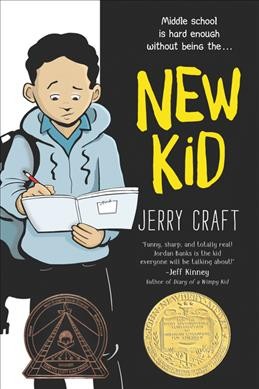
Cara: They’ll just figure, oh, they have their own award. And, you know, people talk about, they already have too many awards for ALA. So I don’t think that they’ll be considering that. There’s a couple that have been awarded in recent years. So probably the most famous is, the only graphic novel that has ever won the Newbery Medal, New Kid by Jerry Craft.
Cara: And that was awarded in 2020, so pretty recently. It’s the story of Jordan, who is at a new middle school where he’s one of the only kids of color. But that’s kind of the opposite of his neighborhood where he doesn’t feel like he sticks out in that kind of way. So it’s just his story of trying to navigate this new world and bridging between both worlds, which is kind of a popular theme when you’re looking at diversity in children’s literature, I would say. The main character is a person of color and the author/illustrator is also a person of color. So definitely a very diverse and forward-thinking choice in the first graphic novel to win the Newbery.
Difficult to separate text from illustrations
Cara: Personally, I really enjoyed this book, but it wasn’t on my list for the Newbery that year. As we’ve been talking about, I feel like it’s really difficult to separate the text from the illustrations. I think all librarians were excited when it won, just because this format was breaking into winning an actual Medal.
Cara: But the book itself I wasn’t particularly enamored with. But I know Stacy is a huge fan. I don’t know if you want to chime in at all since you love it so much.
Stacy: I do. I don’t know if I love it so much because I love graphic novels or because it was just such like a stellar book. I don’t know. It’s just, I thought it was so well done. It’s kind of like Kristine was talking about in our first podcast that we did our earlier podcasts that we did, like, I just feel like middle grade readers, everybody can relate to not feeling like you fit in. And then those readers who you know, really don’t have the same experiences that the character did in the book.
Stacy: Like it’s a good way to see how to show empathy, how to treat others, how you want to be treated. I just thought it was a great book and kind of not a sequel, but a follow-up book to this one came out this year actually. And the title is escaping me. I can’t think of it.
Cara: It has a red cover, right? That’s so helpful, we get that all the time. It was this color.
Stacy: I can’t think of it, but it’s in the same vein.
Kristine: Is it Class Act? Is that the title? Yes, that’s right. Good memory stuck in my mind.
El Deafo

Cara: Awesome. Yeah. So yeah, that one’s definitely notable just because it was the very first to win an actual Medal. Now we’ve had other ones win Honors before. So this one is El Deafo by Cece Bell.
Cara: This was an Honor in 2015. It’s the author’s graphic memoir of her childhood, growing up as a child who was deaf, although the characters in the book are bunnies. The way that she writes it, it can almost make me understand how they can separate the text because she has so much narration.
Text strong enough to stand alone
Cara: If I can find a good example, you can see all the yellow boxes there, are all her narration, and then you’ve got all the dialogue. To me, I would think that the narration is kind of the backbone of the text when you’re looking at just the text. And I feel like you need a lot of that for it to stand alone and to be seen as distinguished.
Cara: So this one does a really good job with that, but also the dialog is fantastic and the illustrations too. I mean the whole package, that’s the thing. You have to look at the whole thing. But I definitely agree with this one being recognized for Newbery, so I would highly recommend checking that one out.
Roller Girl
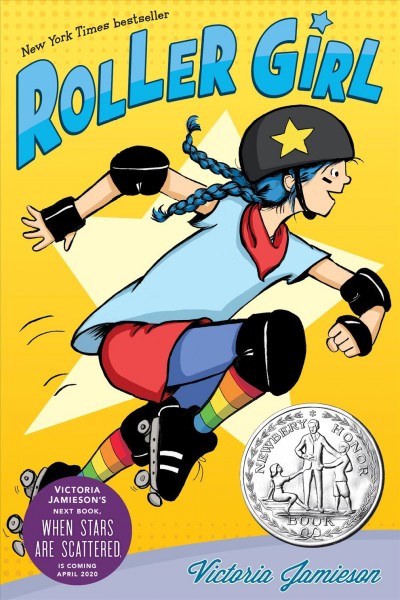
Cara: And then Roller Girl by Victoria Jamieson. This one won an Honor in 2016, and I absolutely loved this book when it came out. I remember book talking it when I was visiting schools. It just has a great story. The main character Astrid, her best friend has decided that she wants to do, I believe it’s ballet camp, for the summer, so she kind of just dumps her friend for the summer.
Cara: And so Astrid’s kind of left, just kind of casting about, she doesn’t know what to do, and she decides she’s going to go out for roller derby, even though she doesn’t know how to roller skate. So kind of stepping out on a limb there. But she gets there eventually, and it’s a coming of age story, that very classic, like finding herself.
Great illustration
Cara: But the illustrations are absolutely fantastic. It’s got a lot of action in there, as you can imagine with roller derby. And again, this one has quite a bit of narration that goes along with the dialog, so I can see how the text is distinguished there. So yeah, another one I recommend. And then I’ve got some picture books, so those were all the graphic novels that I wanted to highlight.
Cara: Traditionally, picture books are recognized for the Caldecott Medal, which is awarded yearly by the American Library Association for the most distinguished American picture book for children, and they’ve definitely expanded that over time as well to include other formats. So it’s interesting to see how that Medal has kind of gone forward in time, keeping up with new formats and things like that, but I think that’s a whole other podcast on its own.
Cara: So if the text is truly distinguished, Newbery’s age range does include picture books. There’s nothing to exclude them. But, of course, they can only consider the illustrations if they negatively impact the book.
Box: Henry Brown Mails Himself to Freedom
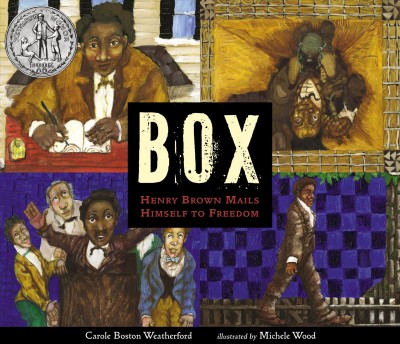
Cara: They say, “make the book less effective.” So again, not sure how they do that. But for the 2021 awards, so just this past year, we saw a picture book honored. It’s called Box: Henry Brown Mails Himself to Freedom by Carol Boston Weatherford. The whole book is just fantastic, because you can’t discount the illustrations.
Cara: They’re just gorgeous. They’re done in mixed media. But I think what made this one most successful and able to kind of separate the text and show how it’s distinguished is because it’s poetry. I think that that really helps it stand on its own. I think it’s even more impactful when it’s combined with the illustrations, but it can stand on its own.
Cara: So I think it has an advantage in that. It just goes through his life; it’s his biography. Each poem is, you have to read the information in the book to read about how they’re set up, but from what I understand, all of them are six lines and she was trying to mirror the box that he’s in.
Cara: So six sides to a box, six lines to each poem. It’s really interesting how well thought out it is. But the text is just fantastic, the way that she portrays his life and goes through all the hardships he went through as a slave. I think a lot of people have heard at least this portion of his story, where he decides to mail himself to somewhere where he can be free.
Crown: An Ode to the Fresh Cut
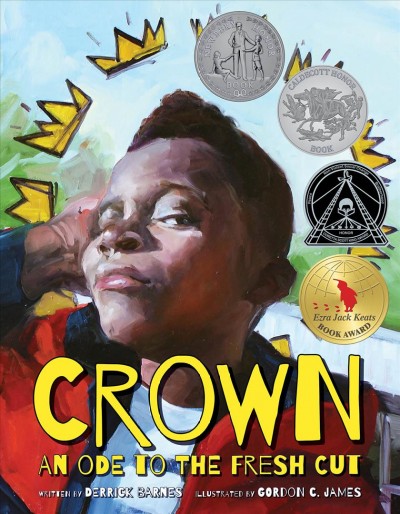
Derrick Barnes
Cara: All around just a wonderful book and definitely worthy of, this one doesn’t have a sticker, of its Newbery honor. And then we’ve seen a couple other picture books get Honors. And then there’s one that’s gotten the Medal. So this one [Crown by Derrick Barnes] was an Honor as well. And this one was cool. We were talking about sticker placement in our first podcast.
Cara: Sadly, this one does not have any stickers on it, but it was really cool because this one won a lot of awards. So they kind of put them along the crown on the top. And it was really neat to see that when they lined them all up. It’s called Crown: An Ode to the Fresh Cut by Derrick Barnes. And this one is also, I don’t know if they technically consider it a poem, but it definitely feels like a poem.
Cara: So again, I feel like this kind of text really lends itself to separating the text out and seeing how it’s distinguished for an illustrated book for the Newbery. It’s about an unnamed black main character who’s talking about his experience in a black barber shop. So it’s very specific. But I think it can be generalized to people.
Cara: So he’s just talking about how his haircut gives him his identity, makes him feel important and powerful. So I think a lot of us can relate to that. We were actually talking about each other’s hair before we started this podcast. So definitely relatable for a lot of people, I think, and just really lyrical.
Cara: I love the way that it’s written. And of course, I’ll open it so you can see the illustrations, which are also fantastic, but not considered for Newbery.
Stacy: I don’t understand. I know I could never serve on the committee
Cara: We’re having a tough time. We just can’t separate them.
Last Stop on Market Street
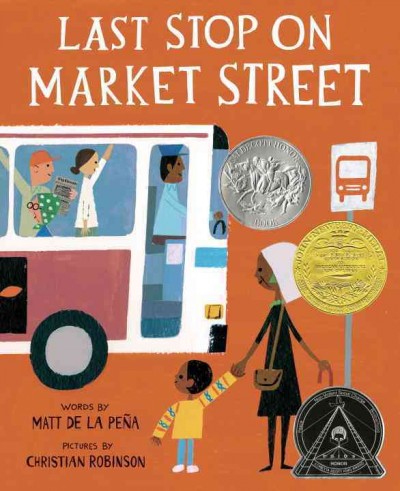
Matt De La Pena
Cara: So I’ll finish this section up on picture books with the only picture book that’s ever won the Newbery Medal, which is Last Stop on Market Street by Matt de la Pena, who is a fantastic author.
Cara: I’ve heard him speak. He’s a wonderful person. Very much admire his works, but I was definitely confused when it won the Newbery. And I still don’t know that I agree with it. Now, this book also won a Caldecott Honor for its illustrations, which were done by Christian Robinson, who I absolutely adore.
Is the text distinguished?
Cara: And I think it’s well-deserved for that. I just, looking at the text on its own, I don’t see how it’s distinguished. The two of them together, absolutely. But the text is just very, very simple. The story is, CJ and his Nana are going on a bus trip to serve at the soup kitchen. And CJ is learning how to look at everything around him in a different light, kind of seeing it in a new way.
Cara: His Nana’s helping him do that. So I love the theme of the story. I just had a hard time. Maybe I need to type up the text and just look at it by itself, and see if I can get on board with just the text. But yeah, so I think there was a lot of, like, “what??”, when that happened.
Illustrations work well with the text
Stacy: I agree with you. I think together the book is magical together. It’s just such a wonderful story and the illustrations are so kid-friendly and just, I mean, they’re just beautiful, but yeah, on its own, not that it’s not deserving of you know, any other medal or maybe even a Newbery honor, but of all the books published that year, not one other book was more deserving of the most distinguished for children’s literature. I just don’t know. I didn’t read as many books as they did that year. Of course. So maybe it was, but yeah, it’s just, it’s that’s hard.
Cara: Yeah. I don’t know if I mentioned, it was 2016, and I do not have my list here, my comprehensive Newbery list.
Cara: I do have one, but don’t have it here, to see what other books, I can’t remember what got Honors that year or what else was published, but yeah, I don’t know, but every committee kind of comes up with their own thing and of course they didn’t know what the Caldecott committee was doing either, so.
Stacy: So, it’s so interesting that there’s overlap though, and several choices and several different years there’s been some overlap.
Nonfiction
Cara: Yeah. So I’m going to turn it over to you guys for nonfiction.
Bomb: The Race to Build and Steal the World’s Most Dangerous Weapon
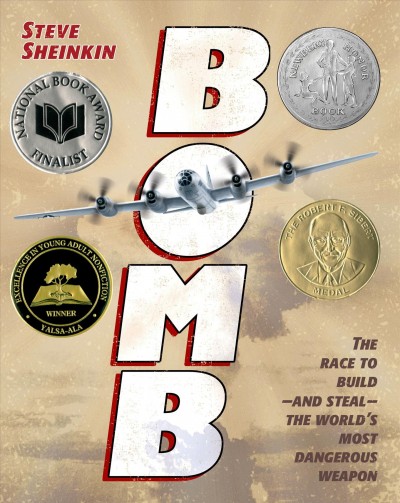
Stacy: So I’m going to talk about my favorite non-fiction Newbery. It’s actually an honor book. It wasn’t a medal. But it is this one here. If you guys can see it, there’s a whole horrible glare on it, but Bomb: The Race to Build and Steal the World’s Most Dangerous Weapon by Steve Sheinkin. And it won a Newbery honor in 2013. So being librarians, I feel like Steve Sheinkin is an author that we always go to when we’re recommending great narrative non-fiction for people who just like want adventure stories, but they have to read a nonfiction book for school.
Stacy: I feel like Steve Sheinkin is a go-to because he has several that are kind of in this vein. So this one here Bomb. So in December of 1938, a chemist in a German laboratory made a shocking discovery: when placed next to a radioactive material, a uranium atom split in two, and that simple discovery launched a scientific race that spanned three continents.
Stacy: So in great Britain and the United States, Soviet spies worked their way into the scientific community. And in Norway, a commando force slipped behind enemy lines to attack German heavy water manufacturing and all the while deep in the desert in New Mexico, one brilliant group of scientists was at a remote site at Los Alamos.
Synopsis
Stacy: So, this is the story of the plotting, the risk-taking, the deceit and the genius that created the world’s most formidable weapon. It is the story of the atomic bomb. This is one of my all-time favorite books I’ve ever read all the books I’ve ever read, not just non-fiction. And like I was saying, I recommend it heartily to both teens and adults, as it reads like a thrilling fast paced spy novel.
Stacy: It is wonderful narrative nonfiction that will have you on the edge of your seat while simultaneously learning about the cold war. It won numerous awards, including the Newbery honor, and it was actually a national book award finalist as well. So it’s perfect for those who enjoy spy thrillers and war accounts and even reluctant readers.
Appeal
Stacy: So, it has a really wide range of appeal yet it is meticulously detailed and expertly written. So to me, no wonder it won a Newbery honor. I think the bibliography in the back is like, not just as long as the text, but it’s pretty close. Like it was pretty expertly researched and written and it has like we were saying about illustrations, the photographs have no bearing on it, winning a Newbery, honor, but you have all of these like wonderful, like first and secondary sources with these photographs and stuff.
Stacy: And it tells you exactly what you’re seeing in the photographs. It was just so interesting for someone who doesn’t really know anything me about the cold war, or really like, that’s not something I would normally just pick up. Like if there was a fiction title about the cold war, I’d be like, eh, but this was actually one of the first kids non-fiction books that I read as a student in library school.
Stacy: So, we had this class where we, all we did was read and write a reviews, but we had to read from specific lists. And of course, this was on the list as a Newbery honor. So I chose it and it was my first, I think it was my first Steve Sheinkin book I read. And I’ve read several others of his and his writing is just fantastic. So I love this one very much.
Kristine: I also really enjoyed that book. One of my favorite genres is historic fiction. And it reads just like historic fiction. Like you said, it’s, you know, if you like spy thrillers, if you like history if you like science, that one definitely have a lot of science in it. It’ll keep you on the edge of your seat.
Sequels
Fallout: Spies, Superbombs and the Ultimate Cold War Showdown
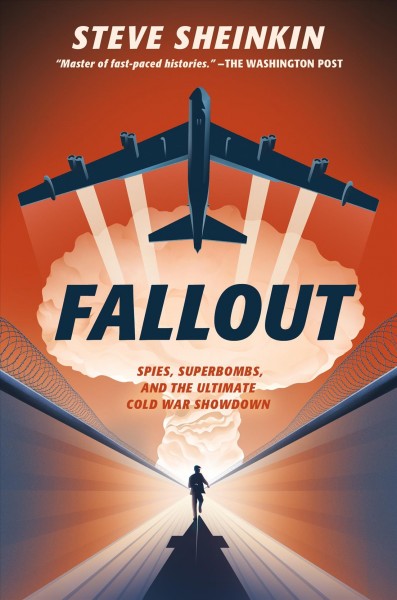
Kristine: And with that I’m going to talk about some of the 2022 contenders and I have the sequels. So that book here is called Fallout: Spies, Superbombs, and the Ultimate Cold War Showdown. So it basically picks up where Bomb left off. Bomb was about building the atomic bomb during World War II.
Kristine: And this one then goes into the cold war where they are building the super bomb or the hydrogen bomb, which is immensely more powerful than the atomic bomb that they used in world war II. Now I must say I have not finished it yet. But it is just as good as Bomb. You know, it keeps you on the edge of your seat wanting to read and find out what’s going to happen next.
Kristine: And just the fact that it is all true. All of the things that it’s talking about really did happen. I just, I think makes it that much more appealing and just like Bomb. He’s got pictures that kind of aid in the story. And I really like how he he’ll show pictures of the, all the different characters of all the people that are involved in the story that kind of can help keep things straight as you read, because you know, it’s talking about all of the different spies in the U S and in Russia.
At least an Honor books
Kristine: So I think that definitely helps, but I think this definitely has a good shot of being at least in honor book. Like I said, it is right up there with Bomb. If you haven’t read it, I, again, I would highly recommend reading it. It will keep you on the edge of your seat. And I’ve learned a lot that I didn’t know.
I like to read historical fiction, but I haven’t read much about the cold war. So I’m learning a lot that I did not know. So I think this is a great one. It’s recent, I’m trying to think. When did it come out? Just within the last month or two, so it’s a little bit newer on the Newbery list for 2021, but I hope that people have a chance to read it.
Stacy: I have a copy checked out right now and I haven’t had a chance to start it yet, but I knew it would be wonderfully written because of the author. But I’m, I’m so glad to hear you say that its just as good as Bomb.
Kristine: What I’ve read so far, I’ve really enjoyed. And like I said, it’s, it’s one of those where I tend to stay up a little later than I should because I keep reading.
Gone to the Woods, Surviving a Lost Childhood

Kristine: A couple other non-fiction titles that I want to mention that are getting a little buzz this year. And I actually, the next one, I don’t have a copy of, they were all checked out and I’m actually listening to it through Libby, one of our apps and that is called, Gone to the Woods, Surviving a Lost Childhood by Gary Paulsen.
Kristine: This is his most recent memoir and it basically chronicles his life from about the age of five up through the, I think the end that he’s about 16 and this one again I think tends to lean on the older side. There are parts of it that I think would appeal to a wide range of ages, but there are some parts that I think are a little bit more mature.
Kristine: So, you know, I don’t know if this is one that’s considered by the Newbery, If they consider that. But I really enjoyed this book. I think it will appeal to kind of the upper middle grade boys. It’s got a lot of outdoorsy adventure and Paulsen just has a way with words.
Way with words
The way he describes the setting and the encounters he has. I mean, it’s not just what he sees, but he talks about how it feels, how it smells. I feel like there were a lot of parts of this book where he was talking about smells and not always pleasant, smells. And how things feel. I think he just really has a way of giving really vivid, detailed descriptions.
Kristine: And he just had a really when you look at his childhood and the things he encountered It just really unique and interesting life. So I would highly recommend this book. Again, I think a little bit older audience but I thought it was, it was great. And it gives you some perspective if you’ve read any of his other books like Hatchet as to where those stories came from.
Much love
Stacy: Yes, I read it. I loved it. I definitely agree with your assessment that it’s for a little bit older age group, as, like you said, he does not really sensor anything and it is based all on his childhood. It’s all true. And it’s heartbreaking. I just like, can’t imagine that like a little five-year-old boy was put on a train all by himself and sent hundreds of miles away across the country.
Biscuits
Stacy: Like just what he went through and how he lived was just amazing. But like you said, has a way with words. Like just love to have his aunt when he goes and lives with his aunt and uncle on their farm and she makes biscuits and stuff and he talks like, he just, like you said, the way with words, he talks about how they smell, how great they taste.
Stacy: He’s never tasted anything like that before. And I would just love to have her recipe for those biscuits. But I think my favorite part of that book is like, kind of towards the end and I won’t spoil anything, but he just has this beautiful, like ode to libraries and librarians because reading and books is what, like, kind of saved him and inspired him to become this wonderful author.
Stacy: And we miss him very much. We’re so sad to hear about his passing, but yeah, such a good choice, Kristine. I hope it gets some good accolades in 2022.
Runaway, the Daring Escape of Ona Judge
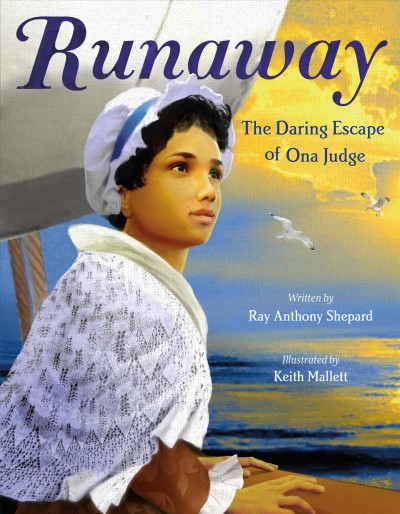
Ray Anthony Shepard
Kristine: Me too. All right. So I do have one more nonfiction and this actually is going to kind of hit what Cara was talking about with picture books. So it’s a picture book, nonfiction, it’s called Runaway, the Daring Escape of Ona Judge and this book it’s actually a poem as well.
And it reflects on the true story of Ona Judge who was actually a slave in the Washington family. So George Washington, our first president, she was a slave in his family and it reflects on why she wanted to run away.
Kristine: It’s one poem and it revolves around the phrase “why you run away Ona Judge.” It keeps coming back to that and looking at why she wanted to run away, even though she was the slave in the Washington house and it seemed like she had a good life and it keeps coming back to why she wanted to run away.
Slavery
Kristine: It boils down to the fact that she, even if she had a good life as a slave, she was still a slave. And the words that the author uses just kind of build on that fact that she was a slave, that she was property, even though she was treated well. But we see at the end, she actually does run away.
Kristine: And again, this is a true story and she’s able to have the life that she always dreamed of, her own life. And I think that again, because it’s poetry, if you take away the words or I’m sorry, you took away the picture. It’s not the word that will definitely not work. If you take away the pictures and you just look at the text, it’s very, very powerful text.
Kristine: And that I think can stand on its own now, compared to all the other books that we’ve talked about for the Newbery, does this one have a chance to win? We’ll just have to wait and see, but I thought it was a great story. And again, it’s very powerful. The text is very well-written.
Kristine: So again, another kind of very nontraditional, non-fiction picture books. So that’s the last non-fiction title I had. But I do have one more.
Harry Versus the First 100 Days of School
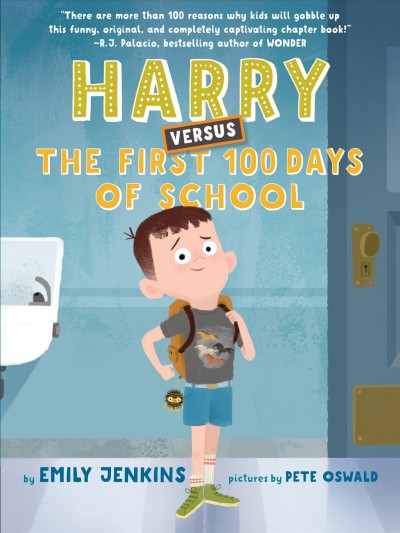
Emily Jenkins
I want to mention that is nontraditional in a sense that we haven’t really talked about. And that is this adorable book called Harry Versus the First 100 Days of School.
Kristine: And this is by Emily Jenkins and it is nontraditional. And most of the ones we’ve talked about in our traditional Newbery award podcasts are aimed at kind of eight to 12 year olds. And this is an early chapter book that is geared more towards the five to eight year old age range and writing a, what Newbery would consider a distinguished book for that age range can be really difficult.
Younger readers
Kristine: You know, trying to make something that is engaging yet, still readable for those younger kids. It can be really hard. So in this book, as the title tells Harry is going to first grade and it chronicles each of his first 100 days. It’s written in very short chapter each day is a chapter.
Kristine: So I think that definitely helps to make it readable. But those chapters are far from simple and boring. It does a great job of capturing what the classroom is like, the setting of a first grade classroom. She captures his personality really well, the challenges and fears that he goes through, how he relates to his classmates.
Kristine: Gradually throughout the course of the book you learn about their personalities. She just captures all that in a very realistic, funny, heartwarming way that I think kids will love. And I think adults will enjoy this as well. Kind of give them a little trip down memory lane, remembering what it was like to be in elementary school.
Kristine: So I think she does a great job of with the text in this book and for this age group, I think it is very distinguished and should at least get a second look. So again, Harry Versus the First 100 Days of School, very cute. I would highly recommend this book and think it could have some potential for Newbery.
Kristine: I think Cara, and you may know this, I think there’s only maybe been one other early chapter book that’s gotten a Newbery. Was it one of the Billy Miller?
Cara: Oh, yep. Yeah, that one did win an honor. So yeah, it’s kind of hard to know what they, how they consider those, because I’m sure they look at them. I would hope. But yeah, we don’t really see them mentioned or recognized hardly ever.
Stacy: I haven’t read that one, Kristine, but it’s gotten so many good reviews. I think it’s gotten a couple starred reviews and just saying how well it’s written. So I never really thought of it as a contender for Newbery, but I feel like it, I mean, that’s a good possibility and I think that’s a good prediction on your part.
Appeal for older readers too
Kristine: Yeah, we’ll see, but I see, I would highly recommend it. It’s a quick read for, you know, for an adult, but it’s very cute. So, you know, who knows for Newbery, but I would highly recommend it and it would definitely be one that I would promote to, to kids in that age and to teachers.
Cara: I was just going to say, hopefully that’s something we’re doing with all of these, is promoting them. Even if, you know, they might not win or we might not think they’ll win, because the rest of my books, I don’t necessarily think they’ll win, but we wanted to look at some other nontraditional ones.
Other predictions
Stacy: I was just going to say let’s, I think we’re flipping back to Cara to talk about a couple of maybe other predictions.
Cara: Yes. So, as I said, my predictions are that they won’t win the Newbery, but I think they’re fantastic books in their own right, and since we were talking about nontraditional titles, I wanted to look at some with visual elements.
Visual elements
Cara: So I took some of the best graphic novels and picture books that I’ve seen this year. So obviously I have not seen all of them, this is just from what I’ve read, but from what I’ve read, the best of the best in these categories, I don’t think will win the Newbery, but I would still recommend checking them out, taking a look at them.
Caldecott
Cara: And it might give you an indication for Caldecott. So we’ve been talking about Caldecott a little bit, just because we’ve looked at so many illustrated books. That’s typically what we think of for illustrated books is Caldecott, and it’s not unheard of for books for a middle grade or upper audience to win a Caldecott or an Honor, at least.
This One Summer
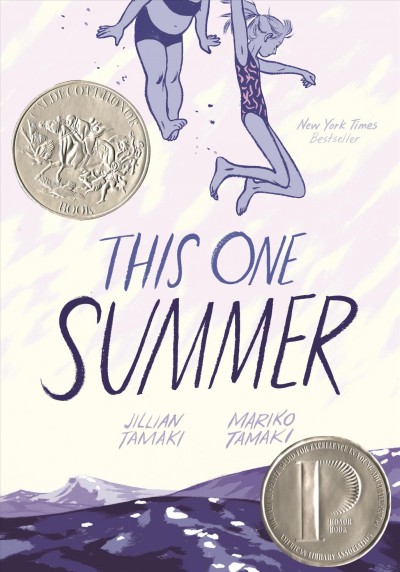
Cara: We’ve seen a graphic novel, it’s not in any other categories, called This One Summer by Mariko Tamaki and Jillian Tamaki, which is very much on the upper range. I actually don’t know what the age range for Caldecott is. They just say it’s for a picture book for children.
Cara: But that one’s recommended for ages 13 and up, so definitely on the upper end of Newbery. But it wasn’t recognized at all for that. It got a Caldecott Honor in 2015.
The Invention of Hugo Cabret
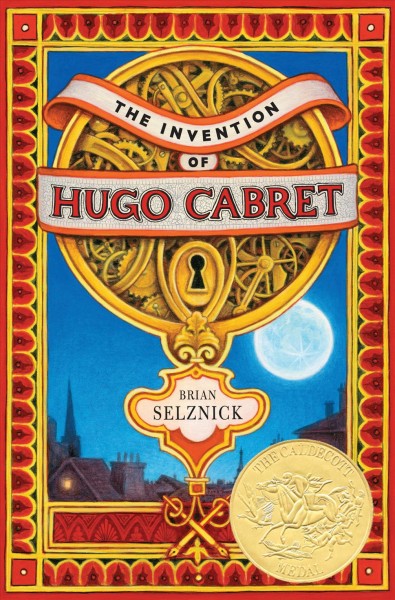
Brian Selznick
And then of course I think most people are familiar with The Invention of Hugo Cabret by Brian Selznick, which is what I would call a hybrid middle grade novel.
Cara: It’s got definitely the middle grade audience in the text part, but it’s heavily illustrated and was actually awarded the Caldecott Medal in 2008.
Stacy: He does whatever he wants and it works for him. It really does.
Kaleidoscope
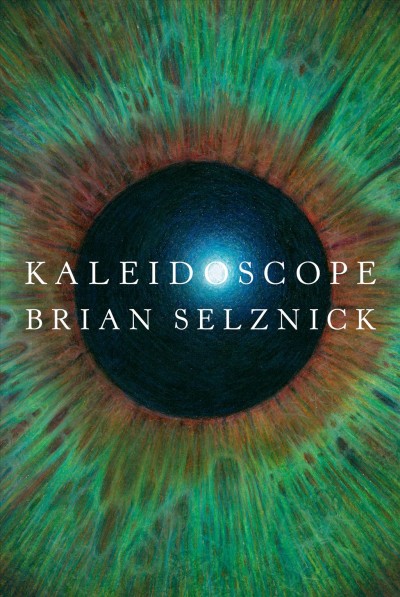
Cara: Yes, definitely. And his new one, I’m sure the committee will consider it. It’s called Kaleidoscope. It’s one of the many books that, I don’t know what kind of reading slump I’m in, but I picked it up and put it back down. So I did not read that one, but I’m sure they’ll consider it. We’ll see what happens with it. So I’ve got two graphic novels and two picture books.
Garlic and the Vampire
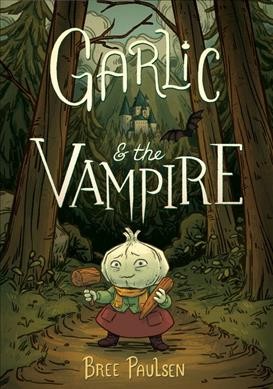
Cara: This is my favorite graphic novel that I’ve read all year. It’s called Garlic and the Vampire by Bree Paulson. So it’s authored and illustrated by the same person. And it’s just precious. It’s a group of vegetables that are animated by this witch to help her in her garden. Which if you think about it too much, it’s a little disturbing because they’re gardening, like Garlic gardens garlic, and then takes it to the farmer’s market to sell.
Cara: So it’s a little strange, but those aren’t animated, they’re just vegetables. So if you think about it that way. What happens, the plot of the story, is that they notice that there’s a vampire in town. And so of course, all the other vegetables nominate Garlic to go take care of the vampire.
Cara: And she’s very worried about it. You can see she’s got her stake here. But of course, being garlic, they feel like she’ll be naturally protected from a vampire. So it’s just a very sweet story, and I love the earth tones that it’s done in, and it definitely reflects the gardening theme and the vegetables.
Cara: But I don’t feel like the text on its own is distinguished enough for Newbery because it’s all dialog. It has no narration. And there is so much emotion that the author/illustrator puts into it. You can see her [Garlic’s] face; Celery, he goes with her. And then he’s like, “I’m out of here” and abandons her.
Cara: But you can see how much emotion she puts into their little vegetable faces. So you have to have these illustrations, you really can’t separate them. But they’re just precious. So I would definitely highly recommend this one and I believe this is, it says it’s her first traditionally published book.
Cara: So she did have another book about a vampire that was a web comic and she self-publishes them, but this is her first [physical] book. So I would definitely check that one out.
Stacy: So cute. I love the illustrations. I hope it’s not her last book. I hope she keeps publishing.
Delicates
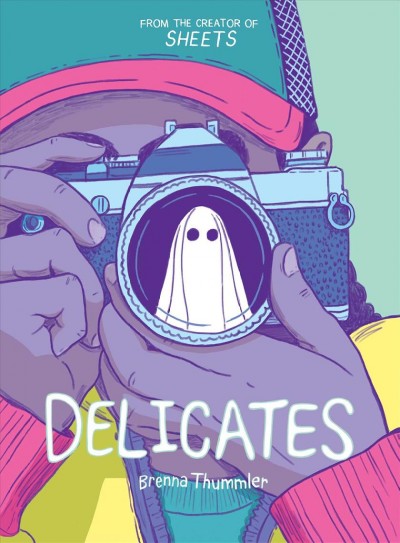
Cara: For kids too. I haven’t looked at her other one. I think that one’s targeted at adults, but she does a fantastic job for kids, so I hope she will keep coming out with them. My next one, my other graphic novel, is Delicates by Brenna Thummler, which is the sequel to Sheets, which was her first graphic novel as an author/illustrator. She also illustrated the graphic novel version of Anne of Green Gables, which has a special place in my heart.
Cara: She did a fantastic job with it, so I love her illustrations. And again, I feel like you can’t do without them in this book. So it’s a really wonderful book. I love the themes that are going throughout it, of the main character Marjorie. She’s trying to figure out how to fit in. And then the other main character, I can’t remember her name, Eliza.
Cara: She’s the one on the cover with the camera. She’s also kind of on the outskirts of her classmates. And so it’s kind of about how are you a true friend, and how do you help the people around you? And of course, it’s got this fantastical element with the ghosts that were part of the first one, Sheets. So kind of a couple of different genres in there.
Cara: I love her color palette with these pastels that she uses and the pinks and the greens and the blues. It’s just really beautiful. But again, tons of dialog, lots of wordless panels, so I just feel like you have to have the art. And the dialog does a good job of distinguishing between the characters.
Cara: But I don’t feel like it’s distinctive enough by itself to win a Newbery just for text. So again, I would recommend it as a graphic novel. For Newbery, I don’t think it’s going to go anywhere, but you never know.
The Secret Fawn

And then I’ve got two picture books. The first one is The Secret Fawn by Kallie George, and it’s illustrated by Elly Mackay.
Cara: And when I opened this one, I mean, I was just astonished. It’s cut paper illustrations backlit by light and they’re just gorgeous. So I’m very much hoping that the Caldecott committee will recognize this one. The story is this little girl whose family sees a deer and she really wants to see a deer in their yard.
Cara: So she goes out before breakfast and she’s looking for the deer. So it’s a very quiet story. Just really lovely, along with the illustrations, but I feel like for a Newbery committee who’s looking for distinguished text, it’s just very simple. I don’t think there’s enough there for them to say that it is distinguished in plot or character development.
Cara: There’s just not enough there, but for the Caldecott committee, for them to look at these illustrations, they’re just gorgeous. There’s the little fawn at the end. It’s very sweet. If you like quiet picture books.
Stacy: I think cut paper illustrations might be my most favorite media or form of illustrations. They’re just so delicate. And I’ve watched a couple of videos of the artists who make them I mean, everybody does it a little bit differently, but the one I was watching and I can’t think of her name, but she makes like little dioramas almost and sets all her paper pieces up. And, and like you said, they’re backlit. And then she takes photographs of them. And the photographs are what ends up as the illustrations in the book. And that just blows my mind.
Cara: Yeah. And it gives them such texture. I think maybe that’s why they’re so appealing, because they don’t feel like illustrations. You know, they’ve got that tactile element to them.
Stacy: Good choice.
Cara: I’m sure you probably ordered this, so good choice on you, because I wouldn’t have seen it if you hadn’t ordered it.
Stacy: I ordered this one too.
It Fell From the Sky
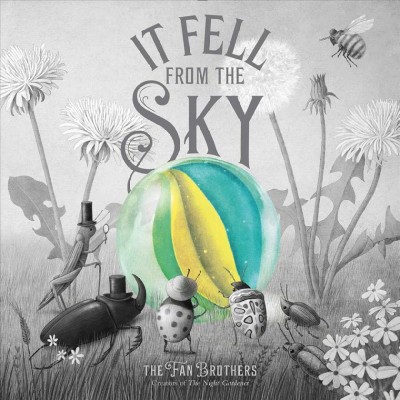
Cara: Yay! I love the Fan Brothers; this one is their newest, It Fell from the Sky. Last year, they had The Barnabus Project, which I adored; my oldest kid, who’s six, adored it. So I would highly recommend checking them out. This one is the story of what happens when a marble invades this community of bugs.
Cara: So it literally falls from the sky and they don’t know what it is and they’re trying to figure it out. So the text in this one is pretty straightforward, but I feel like you just have to have the illustrations. They’re very detailed and then they’ve got these pops of color, so the very selective use of color with the marble, but just gorgeous, all these bugs.
Cara: So they’re all kind of exploring it, and then the spider takes over. I love the frog. He tried to taste the marble; he thought it looked like food. So the spider decides to commercialize the marble. He’s charging leaves for them to come see it and kind of takes over, and then everybody stops coming.
Cara: And so it’s kind of this message about being selfish, and what happens when you try to commercialize something. But then the marble gets taken away. Just gorgeous illustrations. And the text is a little bit lyrical, I would say, but just not to the degree that it needs to be to be distinguished.
Cara: And then at the end, it’s in full color; they decide to take all these other things that fall from the sky and they’re free for everyone to look at. So very, very sweet story. I loved the bugs. I just don’t think it’s there for Newbery, but hopefully Caldecott. I’ve been hoping for them to be recognized for a while and they just haven’t been. So we’ll see.
Stacy: Hopefully all of our predictions come to fruition. We don’t know. We won’t know until they’re announced, which is next year. So we will be anxiously waiting the announcement of the Newbery award and all the other youth literature awards, including the Caldecott. So viewers, you can watch the 2022 American Library Association Youth Media Awards live virtually on January 22nd, 2022 at 8:00 AM. Eastern time. A live video stream will be available at ala.unikron.com.
In conclusion
Thank you two for joining us and thanks everyone for watching. Listeners, remember to subscribe so you don’t miss an episode. Viewers, follow the Clermont Library YouTube channel for this and other great library content. You can find all of the books we talked about in our catalog or in our digital collection via Libby, Hoopla, or Freading.
Cara and Kristine, thank you both so much for joining us and talking all things Newbery.
You might also enjoy
Podcast: Play in new window | Download



